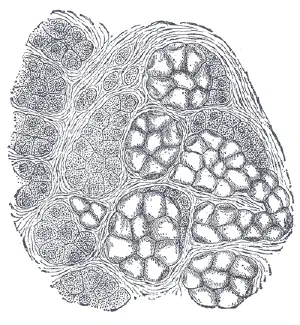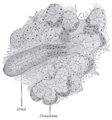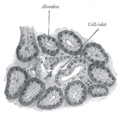Gland
A gland is a collection of cells (tissue or an organ in an animal's body that, utilizing substances from the blood, produces a newly sythesized or concentrated chemical substance for secretion, either for use by another part of the body or for elimination from the body. For example, it may synthesize a hormone for release into the bloodstream (endocrine gland) or secrete it directly into cavities inside the body or its outer surface (exocrine gland).
Glands can be divided into two groups:
- Endocrine glands. Exocrine glands are those that secrete their product directly into the blood rather than through a duct (ductless glands). This group contains the glands of the endocrine system, such as the hypothalamus, pituitary gland, thyroid gland, adrenal gland, and pancreas.
- Exocrine glands. Exocrine glands are those that secrete their products into ducts (duct glands). Typical exocrine glands include sweat glands, salivary glands, mammary glands, and many glands of the digestive system.
Formation
Every gland is formed by an ingrowth from an epithelial surface. This ingrowth may from the beginning possess a tubular structure, but in other instances glands may start as a solid column of cells that subsequently becomes tubulated.
As growth proceeds, the column of cells may divide or give off offshoots, in which case a compound gland is formed. In many glands, the number of branches is limited; in others (salivary, pancreas), a very large structure is finally formed by repeated growth and sub-division. As a rule, the branches do not unite with one another, but in one instance, the liver, this does occur when a reticulated compound gland is produced. In compound glands, the more typical or secretory epithelium is found forming the terminal portion of each branch, and the uniting portions form ducts and are lined with a less modified type of epithelial cell.
Glands are classified according to their shape.
- If the gland retains its shape as a tube throughout it is termed a tubular gland.
- In the second main variety of gland, the secretory portion is enlarged and the lumen variously increased in size. These are termed alveolar or saccular glands.
Endocrine glands
The human body contains several endocrine glands and cells that secrete hormones which carry out certain functions. The main glands are the pineal gland, hypothalamus, pituitary gland, thyroid gland, parathyroid gland, adrenal gland, pancreas, and the reproductive glands (ovaries in women and testes in men).
A list of endocrine glands is available here.
Exocrine glands
There are multiple ways of classifying exocrine glands:
- Structure. Exocrine glands contain a glandular portion and a duct portion, the structures of which can be used to classify the gland.
- The duct portion may be branched (called compound) or unbranched (called simple).
- The glandular portion may be tubular, acinar, or may be a mix of the two (called tubuloacinar). If the glandular portion branches, then the gland is called a branched gland.
- Method of secretion. Exocrine glands are named apocrine, holocrine gland, or merocrine gland based on how their product is secreted.
- Apocrine glands - a portion of the plasma membrane buds off the cell, containing the secretion. Apocrine gland is often used to refer to the apocrine sweat glands.
- Holocrine glands - the entire cell disintegrates to secrete its substance.
- Merocrine glands - cells secrete their substances by exocytosis. Also called "eccrine."
- Product secreted
- Serous cells secrete proteins, often enzymes. Examples include chief cells and Paneth cells
- Mucous cells secrete mucus. Examples include Brunner's glands, esophageal glands, and pyloric glands
- Mixed glands secrete both protein and mucus. Examples include the salivary glands, although parotid gland is predominantly serous, and sublingual gland is predominantly mucous.
- Apocrine glands - a portion of the secreting cell's body is lost during secretion. Apocrine gland is often used to refer to the apocrine sweat glands, however it is thought that apocrine sweat glands may not be true apocrine glands as they may not use the apocrine method of secretion.
- Holocrine glands - the entire cell disintegrates to secrete its substances (e.g., sebaceous glands)
- Merocrine glands - cells secrete their substances by exocytosis (e.g., mucous and serous glands). Also called "eccrine."
The type of secretory product of an Exocrine gland may also be one of three categories:
- Serous glands- secrete a watery, often protein-rich product
- Mucous glands- secrete a viscous product, rich in carbohydrates (e.g., glycoproteins)
- Sebaceous glands- secrete a lipid product
Types of exocrine glands
Glands typically may be referred to by two or more means, though some terms are rarely seen. The names of the anatomists who first described them are often employed, as:
| name(s) | location | product | structure |
| apocrine sweat glands | skin | - | coiled tubular |
| Bartholin's glands, Tiedmann's glands, vulvovaginal glands | vulva, vagina | - | - |
| Baughin's glands, anterior lingual glands | tongue, near tip | nonserious or mixed | - |
| Brunner's glands, duodenal glands | duodenum | mucous | compound tubular |
| bulbourethral glands, Cowper's glands, Mery's glands | penis, base | - | - |
| Ciaccio's glands, accessory lacrimal glands | eye | - | - |
| Cobelli's glands | esophagus, just above the cardia, in the mucosa | mucous | - |
| Duverney's gland | vagina, on either side | - | - |
| Ebner's glands | tongue | mucous | - |
| eccrine sweat glands | skin | - | coiled tubular |
| esophageal glands | esophagus | mucous | racemose |
| exocrine pancreas | pancreas | serous | tubulo-acinar |
| Fränkel's glands | vocal cords, below the edge | - | - |
| gastric chief cell, Wasmann's glands | stomach | serous | - |
| glomus coccygeum, coccygeal gland, Luschka's gland or ganglion | coccyx, near the tip | - | - |
| goblet cells | digestive tract, respiratory tract | mucous | simple unicellular |
| Henle's glands | eyelids, in the conjuctiva | - | tubular |
| Huguier's glands | vagina | - | - |
| Krause's glands | conjunctiva, middle portion | mucous | - |
| Lieberkuhn's glands | intestines, surface of mucous membrane | - | simple tubular |
| Littré's glands, Morgagni's glands | spongy portion of the urethra | - | racemose |
| mammary gland | breast | - | compound tubulo-acinar |
| Meibomian gland | eyelids | sebaceous | - |
| Moll's glands | eyelids | - | - |
| Montgomery's glands | mammary areola | sebaceous | - |
| Naboth's glands | cervix and os uteri | mucous | - |
| olfactory glands, Bowman's glands | nose, olfactory region | - | - |
| Paneth cells | small intestine | serous | - |
| parathyroid glands, Gley's glands, Sandstroem's glands | thyroid, on surface | - | - |
| parotid gland | mouth | serous | tubulo-alveolar |
| Peyer's patches (or glands) | ileum, lymphatic glands | - | - |
| pyloric glands | stomach | mucous | simple branched tubular |
| sebaceous gland | skin | sebum | acinar - branched |
| Skene's glands, Guérin's glands | vagina | - | - |
| sublingual gland, Rivini's gland | mouth | mucus (primarily) | tubulo-alveolar |
| submandibular gland | mouth | mixed (M+S) | tubulo-alveolar |
| sudoriparous glands, Boerhaave's glands | skin | - | - |
| Sigmund's glands | epitrochlear lymph nodes | - | - |
| Suzanne's gland | mouth, beneath the alveolingual groove | mucous | - |
| Weber's glands | tongue | mucous | tubular |
| Glands of Zeis | eyelids, free edges | sebaceous | - |
Additional images
Section of pancreas of dog. X 250.
ReferencesISBN links support NWE through referral fees
- This article incorporates text from the Encyclopædia Britannica Eleventh Edition, a publication now in the public domain.
mechanism (Merocrine, Apocrine, Holocrine) shape (Tubular gland, Alveolar gland) secretion (Serous glands, Mucous glands, Serous demilune)
Ducts: Interlobar duct, Interlobular duct, Intralobular duct (Striated duct, Intercalated duct), Acinus
Credits
New World Encyclopedia writers and editors rewrote and completed the Wikipedia article in accordance with New World Encyclopedia standards. This article abides by terms of the Creative Commons CC-by-sa 3.0 License (CC-by-sa), which may be used and disseminated with proper attribution. Credit is due under the terms of this license that can reference both the New World Encyclopedia contributors and the selfless volunteer contributors of the Wikimedia Foundation. To cite this article click here for a list of acceptable citing formats.The history of earlier contributions by wikipedians is accessible to researchers here:
The history of this article since it was imported to New World Encyclopedia:
Note: Some restrictions may apply to use of individual images which are separately licensed.






